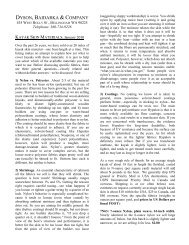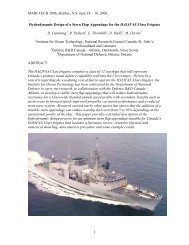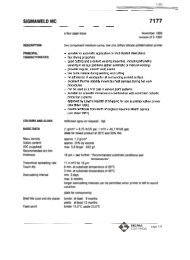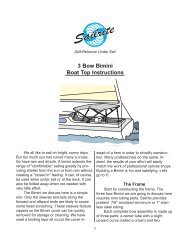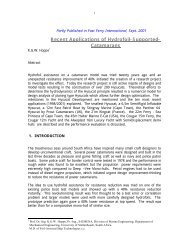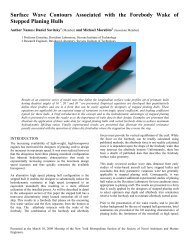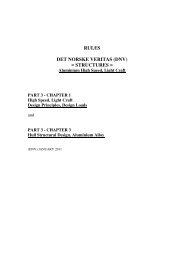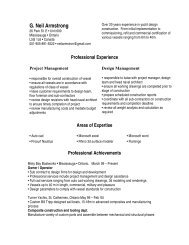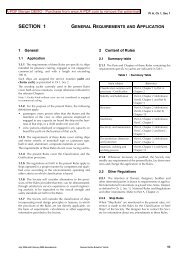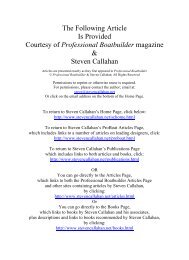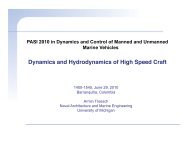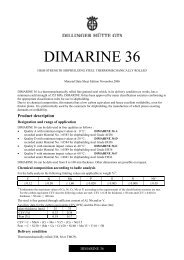Rules for the Classification of Floating Docks - Boat Design Net
Rules for the Classification of Floating Docks - Boat Design Net
Rules for the Classification of Floating Docks - Boat Design Net
Create successful ePaper yourself
Turn your PDF publications into a flip-book with our unique Google optimized e-Paper software.
Chapter 4Figure 5Figure 6h 1ihFFF=5P/(CL ) (kN/m) cCB uB uThe symbols in Fig 3, 4 and 5 indicate:i : minimum centre distance between two rows<strong>of</strong> side blocks, in mP, L c , C : quantities described in [4.4.1]B, B m , B u : breadths described in [1.2.7]b) Bending moment and shear <strong>for</strong>ce1) Transverse sagging bending moment M t ins , perlength unit <strong>of</strong> <strong>the</strong> dock, in kN/mM t sag = 1,25 FBwhere F and B are <strong>the</strong> quantities indicated in a) <strong>of</strong>this item [4.5.2]2) Transverse hogging bending moment, per length unit<strong>of</strong> <strong>the</strong> dock, in kN/mM t hag = D v / (L c B)where D v is <strong>the</strong> light displacement <strong>of</strong> <strong>the</strong> dock, intonnes3) Shear <strong>for</strong>ceT = <strong>the</strong> greater value <strong>of</strong> shear <strong>for</strong>ce per length unit <strong>of</strong><strong>the</strong> dock, in kN/m, given by <strong>the</strong> following two relations:T 1 = (D v · B m ) / 5L c BT 2 = 6 Fwhere D v , B m , B, L c assume <strong>the</strong> values definedabove.4.5.3 Building docksa) Load on floorBWhenever <strong>the</strong> load that may be assumed on <strong>the</strong> transversesections <strong>of</strong> <strong>the</strong> dock may be reasonably representedby a concentrated <strong>for</strong>ce but it is moreconsistently represented by a continuous distribution,<strong>the</strong> conventional load assumes <strong>the</strong> shape illustrated byFig 6.h 1 = 5,4· P/(C² LcB u (kN/m ² )h = 6,4· P/(C² LcB u (kN/m ² )where P, C, L c , B u are <strong>the</strong> quantities indicated in [4.5.2]and <strong>the</strong> total value <strong>of</strong> <strong>the</strong> dashed area is equal to P/(C L c )in t per length unit <strong>of</strong> <strong>the</strong> dock.b) Bending moment and shear <strong>for</strong>ce1) Transverse sagging bending moment per length unit<strong>of</strong> <strong>the</strong> dock, kNm/mM t sag = (1,25 - C · B u /B) · P / (C L c ) · B2) Transverse hogging bending moment per length unit<strong>of</strong> <strong>the</strong> dock, kNm/mM t hag = (D v /L c ) · B3) Shear <strong>for</strong>ceT = <strong>the</strong> greater value <strong>of</strong> <strong>the</strong> shear <strong>for</strong>ce per lengthunit <strong>of</strong> <strong>the</strong> dock, kN/m, given by <strong>the</strong> following tworelations:T 1 = (D v · B m ) / (L c B)T 2 = ( 1 - C B u / B) 6P / (C L c )D v , B and B m have <strong>the</strong> meanings defined above.4.6 Local strength4.6.1 GeneralThe structural scantlings determined applying <strong>the</strong> requirements<strong>for</strong> <strong>the</strong> check <strong>of</strong> <strong>the</strong> longitudinal and transversestrength are to be verified in order to ensure that <strong>the</strong> allowablestate is not exceeded due to local loads. The conventionalcalculation heads, to be assumed <strong>for</strong> <strong>the</strong> purpose <strong>of</strong><strong>the</strong> above-mentioned checks <strong>for</strong> <strong>the</strong> various parts <strong>of</strong> <strong>the</strong>dock, are given in [4.6.2].As an alternative, <strong>the</strong> extreme differential heads anticipatedin operation may be considered in order to determine <strong>the</strong>hydrostatic loads acting on <strong>the</strong> various parts <strong>of</strong> <strong>the</strong> dock; insuch case a detailed description <strong>of</strong> <strong>the</strong> methods <strong>of</strong> operationand <strong>the</strong> checks <strong>for</strong>eseen is to be submitted to RINA <strong>for</strong>examination.Relevant directions are to be reported in <strong>the</strong> operating manual<strong>of</strong> <strong>the</strong> dock.When <strong>the</strong> check <strong>of</strong> <strong>the</strong> local strength <strong>of</strong> <strong>the</strong> structure is carriedout considering <strong>the</strong> loads due to <strong>the</strong> extreme differentialloads, it is also to be verified that, in <strong>the</strong> presence <strong>of</strong> <strong>the</strong>heaviest load <strong>for</strong>eseen in <strong>the</strong> following items, <strong>the</strong> state <strong>of</strong>structures is compatible with <strong>the</strong> limit state. RINA maywaive this requirement, provided that a double check systemis <strong>for</strong>eseen, to be submitted <strong>for</strong> prior approval, ensuring20 <strong>Rules</strong> <strong>for</strong> floating docks 2010



